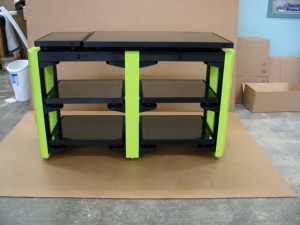 Harmonic Resolution Systems (HRS) makes some of the absolute best audio stands / racks and isolation platforms we have seen. I liked their philosophy so much and had heard so many good things about them, that I ordered a custom made rack in Lamborghini green for my showroom.
Harmonic Resolution Systems (HRS) makes some of the absolute best audio stands / racks and isolation platforms we have seen. I liked their philosophy so much and had heard so many good things about them, that I ordered a custom made rack in Lamborghini green for my showroom.
If like me, you are uncompromising when it comes to quality, HRS is the way to go. So much so that after using my gorgeous rack, I tried to find another distributor for the rack i was already representing. If you have not figured it out by now, HRS is our reference audio rack.
Harmonic Resolution Systems is the name of the company led by Mike Latvis who comes from a heavy duty engineering background. Like me, he is a perfectionist and is un-compromising in his attention to detail. So we hit it off well from the beginning. unlike me, as much as he wanted a red Ferrari audio rack made, he had never done that. So when I suggested a Lamborghini green custom made rack as my own reference audio rack, Mike jumped on the opportunity.
no images were found
Mike Latvis says: ” There are two primary sources of vibration that can significantly degrade the performance of audio systems. The first is structure-borne vibration. The sources of these vibrations often originate from loudspeakers and miscellaneous external disturbances. The energy from these sources is either transmitted through adjacent structures to your audio equipment or is inherent within the design and construction of the component itself. The vibrational energy is modified as it travels from the source to various sensitive components and circuits within your system. The vibration can even be amplified when the stiffness of the supporting structure or the component itself has a natural frequency near the disturbing frequency. The source vibration is often of very broad frequency content, the likelihood of matching the natural frequency of a common support structure or component is highly probable.
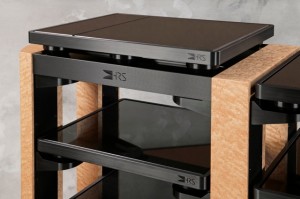 The second source of vibration that can significantly degrade the performance of audio systems is air-borne vibration (sound). The source of this vibration is often loudspeakers, humans, and other vibrating devices within audible reach of the system. Here again, the frequency range is very broad and complex. This vibration has two different paths to your audio system. It travels from the source through the air and directly contacts the outer skin of the audio component. It also travels to all of the structures used to support your audio equipment. A portion of this air-borne energy is translated back into mechanical vibration when it contacts the audio equipment and support structure.”
The second source of vibration that can significantly degrade the performance of audio systems is air-borne vibration (sound). The source of this vibration is often loudspeakers, humans, and other vibrating devices within audible reach of the system. Here again, the frequency range is very broad and complex. This vibration has two different paths to your audio system. It travels from the source through the air and directly contacts the outer skin of the audio component. It also travels to all of the structures used to support your audio equipment. A portion of this air-borne energy is translated back into mechanical vibration when it contacts the audio equipment and support structure.”
Harmonic Resolution Systems answer to this is to scientifically design and manufacture components that eliminate noise. these include audio stands, isolation platforms, and plenty more. For further details please check out HRS website and come back to us. We will be happy to help you.
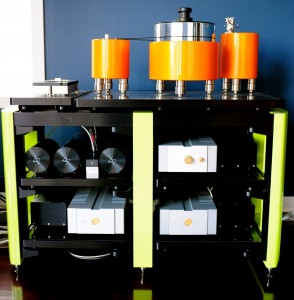 The picture to the right is my custom made HRS audio rack. The design was somewhat tricky. Each isolation platform on the bottom and second level is optimized for my DaVinci Audio preamp, phono stage, and phono stage upgrade as well as EMM CD player. The top shelf includes two isolation bases. A small one and an oversized one to handle the weight of my turntable (about 200 lbs) and also the size of it (huge). Those who know me, know of my interest in the arts as also observed by the fact that there is a whole section on this website dedicated to my personal collection of arts. To me, aside from the functionality and great usability of these equipment, I think of them as a piece of art. Actually, to be honest, this is art and science.
The picture to the right is my custom made HRS audio rack. The design was somewhat tricky. Each isolation platform on the bottom and second level is optimized for my DaVinci Audio preamp, phono stage, and phono stage upgrade as well as EMM CD player. The top shelf includes two isolation bases. A small one and an oversized one to handle the weight of my turntable (about 200 lbs) and also the size of it (huge). Those who know me, know of my interest in the arts as also observed by the fact that there is a whole section on this website dedicated to my personal collection of arts. To me, aside from the functionality and great usability of these equipment, I think of them as a piece of art. Actually, to be honest, this is art and science.
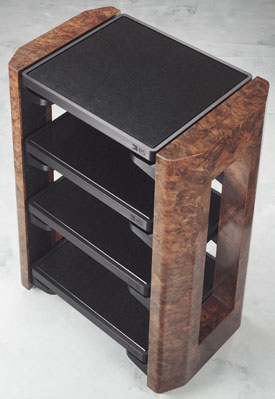
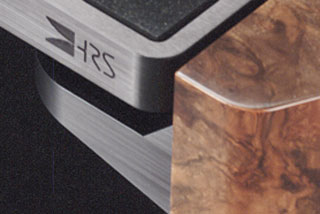
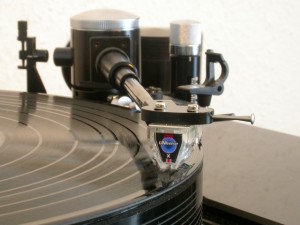
Graham Engineering!
Bob Graham is kind and interesting. He has a dry sense of humor which is up my alley. His is a family business where he works closely with his American and Ethiopian born kids. It took me a couple of years of insistence and a few solid recommendations from other people in the industry to become a Graham representative.
We always seem to have one or two Graham Elites in stock!! Good to know people at high places!
Regarding Graham Phantom II and III, for more details on the leveling system and changes Bob Graham has made to make his great tonearm, even better, I let the man behind the art talk for himself.
There is a lot to say about these tonearms. The technicalities are in three patents filed by Bob Graham. Some of the characteristics are outlined below but at the end of the day, we all judge our audio equipment by the sonic difference they make.
- Removable armwands
- Accurate mass distribution addressing optimal dynamic balance, resulting in minimal moment of inertia
- Neutral balance where the pivot point and the center of gravity of the moving system are in the same plane
Aside from an engineering masterpiece, Graham Phantom II lets you hear the beautiful music you play to its full beauty. Graham Phantom II is Bob Graham’s finest design and implementation to date. Long wait time but SORAsound always ensures to have a couple of extra ones in stock for you. Bob Graham’s mastery with SORAsound’s responsiveness and great customer service.
Below is a quote printed with permission, from a highly respected audiophile who is deeply familiar with many of the high-end tonearms in the market:
“after listening and comparing, there is a new king born, true in tonal color, sensational from dynamic range, and probably the real thing of analog today. The Phantom II is easy to set up, brilliant for mounting cartridge with its own alignment tool, and what i like very much, it works with much more cartridges at top level than other tonearms do.
it has its price but compared to other designs which are more expensive and worse from performance, the Phantom II is a bargain. Definitely one of the rare arms today which will be sought after in a few years as a classic one with real top performance.”
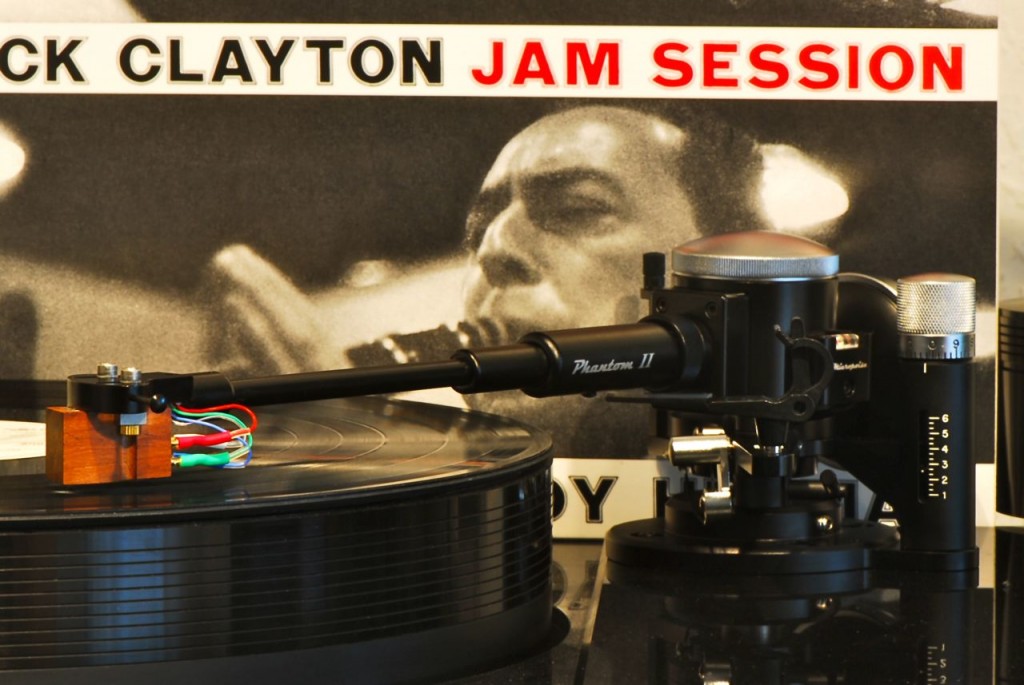
Below is relevant information obtained from Bob Graham’s website and printed with permission.
The original Phantom is the result of over two years of research into design theory, materials analysis, and extensive testing. This involved not only testing of the individual design components as they were being evaluated, but also comparing the several prototype models against Graham Model 2.2 tone-arm as well as other major tone-arms made by other manufacturers.
Bob Graham wanted to design and manufacture a tone-arm that would surpass all his previous efforts, and even exceed what other manufacturers had made to date. At the end, the B44 Phantom II exceeded even Bob’s highest expectations, surpassing even the highly-rated Phantom I.
Graham Phantom II tone-arm has refined magneglide (TM) stablizer, new internal wiring for even better detail and improved freedom from any mechanical resistance, an upgraded pivot design for even greater dynamics, and a new titanium armwand. Together, these improvements yield greater performance in the areas of dynamics and sheer musicality, while retaining the features the earlier Phantom was noted for.
There are many reasons for these significant improvements, covered in three patents, with other applications pending. First, the armtube is easily removable. Using Graham’s patented alignment system, the armwand offers the safety, convenience and accuracy of off-turntable cartridge installation and alignment, as well as allowing quick interchange of multiple pre-mounted cartridges. It is significantly improved from the earlier armwands. It attaches to a nearly half-inch wide stainless-steel post-and-connector that supports the armwand under tension, resulting in virtually a one-piece armtube/pivot assembly with high damping.
Second, addressing the all-important (and often ignored) area of dynamic balance. Tone-arms should have as little inertia as possible. But too often, inaccurate placement of mass distribution results in excessive resisting forces in opposition to the phono cartridge as it attempts to follow the ups and downs of a typical record. The Phantom II, in spite of its robust appearance, has been designed with a very low moment of inertia. Majority of phono cartridges can be used with ease and optimally.
At this point, a brief description of Balance Theory may be helpful. There are basically three types of static balance systems: neutral, stable, and unstable.
Stable balance, normally seen in laboratory scales, occurs when the center of gravity of the moving system is placed below the pivot point. When this type of system is displaced from its preferred rest position, it will generate an immediate and opposing force attempting to return to that original position.
Unstable balance makes no sense for tone-arm design. When the pivot point is below its required position, it will exhibit serious problems including reduced tracking force as the arm is raised.
Neutral balance is the most desirable system for tone-arms. Here, the pivot point and the Center of Gravity of the moving system are in the same plane. When the arm is raised or lowered, there is no opposing force trying to return the arm to a rest position. The pivoting system doesn’t really know or care if the stylus is at the record surface level or a half-inch above or below it. As a result, there is no opposing force to the arm as it is traversing record deflection during play. The only downward tracking force is that of the adjustable counterweight, which remains a constant.
Previously, all true unipivots – that is, those with a single contact point for the bearing and no secondary stablizing surfaces or bearings required the use of side weights or a significantly lowered counterweight to provide stability. In general, those arms with a secondary stabilizer point require a lowered center of gravity to provide constant contact with the stabilizer guide bearing.
The drawback to both these conditions is that this design becomes a stable balance system, which will cause a tone-arm to have a preferred rest position, always trying to return to this point. anytime the tone-arm is raised, as in tracking warped records, it results an immediate and equally opposing force that tries to push the arm back to its rest position. The higher the warp, the more counter-force is applied.
This unalterable law of physics will work against the cantilever, deflecting it during warps, causing the magnetic system inside the cartridge to be displaced.
This, in turn, will certainly affect the reproduced sound, with diminished performance in all areas, including soundstage compression, loss of detail and dimensionality, not to mention record wear. This is why most tone-arms must have their tracking force measured at the record surface level; any height change during the measurement will cause an incorrect reading.
A tone-arm with stable balance can be identified by measuring the tracking force at the record surface level and again at a raised position above the record. If the tracking force increases at the higher position, the arm has stable balance. Bob Graham’s own previous designs – the best he could make at that time – also had this limitation due to the use of side weights to provide lateral stability.
Other unipivots with low-slung counterweights will all exhibit this force; the lower the weight, the more counter-force is applied. Although this technique is often promoted as a “high-stability” design, it does so at the expense of consistent tracking force and linear cartridge performance. . It actually results in varying tracking forces during play when traversing even small warps, accompanied by non-linear cartridge operation, and increased record wear.
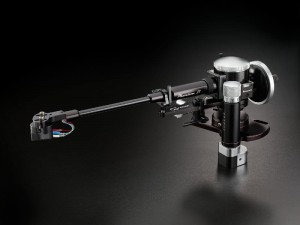 Once neutral balance is chosen for use in a unipivot tone-arm, one must remember that both the vertical and lateral planes will be affected the same way. Without proper lateral stability, such a design would not have consistent, proper vertical alignment, and the pivot would tend to flop over to one side or another. This usually occurs in the direction of the weighted cartridge offset angle mounting, and obviously must be avoided.
Once neutral balance is chosen for use in a unipivot tone-arm, one must remember that both the vertical and lateral planes will be affected the same way. Without proper lateral stability, such a design would not have consistent, proper vertical alignment, and the pivot would tend to flop over to one side or another. This usually occurs in the direction of the weighted cartridge offset angle mounting, and obviously must be avoided.
The answer to this lies at the very heart of the Phantom’s design and its unique ability to retrieve groove information unprecedented in Bob Graham’s experience. The key is a magnetic stabilization system which Bob calls “Magneglide” (TM). With this unique, patented system, all lateral stability, and a portion of the damping, is provided by powerful neodymium (“rare-earth”) magnets placed in a horizontal line from the pivot point of the tone-arm.
Working as an adjustable system, Magneglide (TM) provides the following five benefits: lateral stability, azimuth adjustability, damping assist, true vertical pivoting of the stylus tip with no rotation as the arm is raised, and easily adjusted anti-skate compensation.
In combination with pivot fluid damping (similar to that used with the Model 2.2), the Magneglide (TM) system allows normal vertical pivoting of the tone-arm in true Neutral Balance, with vanishingly low friction; yet, provides a strong lateral stability that feels almost like fixed bearing arms. (No wobbling of the arm as it is lifted, for instance).
In addition, this dual-damped system forces the Phantom to pivot in the correct vertical plane of the stylus tip, with no rotation as the arm is raised. No regular unipivot can achieve this important geometric requirement. Even a few fixed bearing arms don’t get this right!
If the vertical motion of the tone-arm is in plane of the armtube itself (and not the correct plane of the stylus face angle), the cartridge will tend to tip over to its side as the arm is raised, as when tracking over warps. This will cause noticeable channel imbalance and reduced tracking accuracy.
With the patented Magneglide (TM) design, Graham Phantom II has a high-load, chatter-free and virtually friction-free damped unipivot bearing, combined with true neutral balance, and with the all-important geometric accuracy of correct vertical pivoting parallel with the face of the stylus tip.
If all that weren’t enough, the magneglide (TM) system also permits the application of anti-skate through the magnetic coupling of the design, thereby eliminating any direct contact or possible resonance to affect the main pivot assembly of the tone-arm. The anti-skate system is completely independent mechanically. It is easily adjusted either by a thumb-wheel rotation or sliding motion (user’s choice) of the bias weight for minute adjustments from near zero force to 3+ grams.
If your turntable already had a Graham tone-arm on it (to get the angles correct), the Phantom is a true “drop-in” replacement. Although turntable manufacturers may understandably encourage you to use tone-arms of their they manufacture, this is not necessary. The modifications to make the Phantom fit are relatively easy. Bob Graham can provide our customers assistance in this area when needed.
When the Phantom is installed, we are confident that you will agree with many others that it is a significant improvement over any other tone-arm. The proof of course will be in the listening.
 Harmonic Resolution Systems (HRS) makes some of the absolute best audio stands / racks and isolation platforms we have seen. I liked their philosophy so much and had heard so many good things about them, that I ordered a custom made rack in Lamborghini green for my showroom.
Harmonic Resolution Systems (HRS) makes some of the absolute best audio stands / racks and isolation platforms we have seen. I liked their philosophy so much and had heard so many good things about them, that I ordered a custom made rack in Lamborghini green for my showroom. The second source of vibration that can significantly degrade the performance of audio systems is air-borne vibration (sound). The source of this vibration is often loudspeakers, humans, and other vibrating devices within audible reach of the system. Here again, the frequency range is very broad and complex. This vibration has two different paths to your audio system. It travels from the source through the air and directly contacts the outer skin of the audio component. It also travels to all of the structures used to support your audio equipment. A portion of this air-borne energy is translated back into mechanical vibration when it contacts the audio equipment and support structure.”
The second source of vibration that can significantly degrade the performance of audio systems is air-borne vibration (sound). The source of this vibration is often loudspeakers, humans, and other vibrating devices within audible reach of the system. Here again, the frequency range is very broad and complex. This vibration has two different paths to your audio system. It travels from the source through the air and directly contacts the outer skin of the audio component. It also travels to all of the structures used to support your audio equipment. A portion of this air-borne energy is translated back into mechanical vibration when it contacts the audio equipment and support structure.” The picture to the right is my custom made HRS audio rack. The design was somewhat tricky. Each isolation platform on the bottom and second level is optimized for my DaVinci Audio preamp, phono stage, and phono stage upgrade as well as EMM CD player. The top shelf includes two isolation bases. A small one and an oversized one to handle the weight of my turntable (about 200 lbs) and also the size of it (huge). Those who know me, know of my interest in the arts as also observed by the fact that there is a whole section on this website dedicated to my personal collection of arts. To me, aside from the functionality and great usability of these equipment, I think of them as a piece of art. Actually, to be honest, this is art and science.
The picture to the right is my custom made HRS audio rack. The design was somewhat tricky. Each isolation platform on the bottom and second level is optimized for my DaVinci Audio preamp, phono stage, and phono stage upgrade as well as EMM CD player. The top shelf includes two isolation bases. A small one and an oversized one to handle the weight of my turntable (about 200 lbs) and also the size of it (huge). Those who know me, know of my interest in the arts as also observed by the fact that there is a whole section on this website dedicated to my personal collection of arts. To me, aside from the functionality and great usability of these equipment, I think of them as a piece of art. Actually, to be honest, this is art and science.



